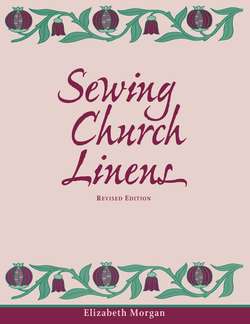Читать книгу Sewing Church Linens, Revised Edition - Elizabeth Morgan - Страница 10
На сайте Литреса книга снята с продажи.
Introduction to the First Edition—1992
ОглавлениеThe past fifteen years have seen an increase in the number of women who work outside their homes. One of the many results of this change has been an increasing awareness of the value of spare time. We have become very frugal with our spare time and are determined to spend it wisely.
The past fifteen or twenty years have also seen the revival of a number of the old crafts: quilting, counted cross-stitch, weaving, crewel, and needlepoint. It is interesting to note that the people who are involved in these crafts are just the ones who are so busy with work outside their homes. Handwork has always been a way for busy people to find respite from the busyness of their lives. Exactly because so many women (and men) find their lives so full of pressures, they are discovering that involvement in altar guilds and in church sewing gives them the sense of spiritual fulfillment and creativity that they need.
Unfortunately, just at the time that church sewing has the potential to become active again, there is very little information on it!
We can tell just how lively a craft is by the ease with which we can acquire materials and teaching texts. Both materials and texts are readily available for the lively crafts of quilting, counted cross-stitch, and needlepoint. The absence of materials and teaching texts tell us that sewing church lines is not a lively craft! Materials are almost impossible to find—reasonably priced linen, fine threads, pins, and needles. What teaching texts do exist are incomplete.
A mystique has grown up around sewing church linens that says that this type of sewing is too complex and too time consuming for the average human being to accomplish. This mystique is false. Providing only that you learn the basic techniques, sewing church linens is neither difficult nor especially time consuming. The mystique develops when we lose our knowledge of the basic techniques. Once knowledge is restored, the mystique disappears. I am no longer surprised when I hear someone who thought church sewing would be difficult say, “You mean, that's all there is to it?” I am no longer surprised when someone who thought she was too busy to take on one more thing brings in her first purificator and is eager to learn to make corporals.
Obviously, sewing church linens can be a time-intensive craft. It need not be so. Any of the small linens can be completed in a quiet evening. Even a fair linen goes very quickly.
We cannot think about sewing our own church linens without touching upon the consideration of cost. Purchasing ready-made linens is a terrifically costly undertaking at a time when the financial resources of our churches are so desperately needed to clothe the naked and feed the hungry. A linen purificator will cost fourteen dollars. We can make the same fine linen purificator for one quarter of that cost. Sewing our church linens is good stewardship.
I would offer you one last thought to ponder as you read. I think that Sunday school teachers and altar guild members come to love their chosen ministries with a particular fervor. You can't love something so much and devote time and energy to it without developing strong opinions about it. In altar guilds these opinions readily become fixed into traditions that say, “But we've always done it this way!”
Several new friends from other dioceses have been kind enough to read this book and give me invaluable advice. Their greatest complaint has been directed toward my adherence to traditions and practices they feel do not coincide with other traditions and practices. You, too, will undoubtedly confront opinions that run counter to the way in which you do things in your diocese or your church.
The range of these opinions is amazing, and the vigor with which they are argued pro and con is strong. Shall we use only linen, or are cotton and cotton blends acceptable, too? Is it blasphemy to lay six yards of 54-inch wide linen on a clean floor to cut it into a fair linen? Is it heresy to only pin a hem, or must hems be basted first? Are knots heretical? Do we risk offending when we mention the burse and veil, since some churches no longer use them?
At first I thought to moderate my opinions so that I might become universally acceptable. To an extent, I have done this; to a large extent, I have not. I love my altar guild ministry. I have opinions, as I am sure you do. I am also sure that you can read my opinions with interest and go on to do what is acceptable in your own church.
Some say this book is too long. I could have given you only instructions. I chose not to because I care so deeply about this beloved ministry that we share.
